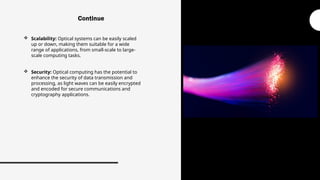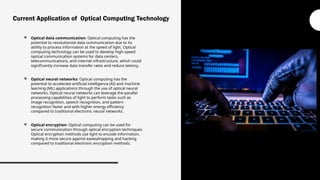Optical computing technology | Computer Science.pptx
- 1. 1 OPTICAL COMPUTING TECHNOLOGY Preseted By Kamal Kumar_BSPS45 Haleema Ali Khawaja_BSPS01 Presented to Sir Rizwan Shabbir
- 2. What is Optical computing Optical computing or photonic computing uses light waves produced by lasers or incoherent sources for data processing, data storage or data communication for computing.
- 3. Early developments in optical computing (1950s-1960s) Introduction of spatial light modulators (1970s-1980s) Holography and optical memories (1960s-1970s) Nonlinear optics and all-optical switching (1980s-1990s) Advances in photonic integrated circuits (2000s-present) Recent developments in quantum optics and quantum computing (2000s-present) History
- 4. Lasers: Coherent and monochromatic light sources used for tasks such as data transmission, signal amplification, and optical data storage. Modulators: Devices that can modulate the intensity, phase, or polarization of light, used for dynamic control of light in optical computing systems. Detectors: Devices used to detect and measure light, converting optical signals into electrical signals for further processing or analysis. Waveguides: Structures that guide and confine light, allowing for controlled propagation of light within a specific region, often used for routing and manipulation of optical signals in optical computing systems. Optical Components
- 5. Optics-based data representation: Data is represented using light, such as binary data being encoded as intensity or phase variations of light, leveraging the high bandwidth and parallelism of light for efficient and fast processing. Optical signal processing: Optical components and techniques are used for tasks such as filtering, modulation, Fourier transformation, and correlation, enabling computations on optical signals. Parallelism and superposition: Optical computing takes advantage of the inherent parallelism and superposition properties of light to perform computations in parallel, potentially leading to faster processing compared to electronic computing. Interference and diffraction: Interference and diffraction of light waves are utilized for computations, involving the interaction of light waves and the bending or spreading of light as it encounters obstacles. Basic principles of optical computing
- 6. Nonlinear optics: Nonlinear optical effects, such as frequency mixing, phase modulation, and optical switching, are utilized for performing nonlinear computations and routing optical signals. Photonic integrated circuits (PICs): Compact, chip-scale devices that integrate various optical components and functions on a single chip, enabling scalable and integrated optical computing solutions with reduced size, weight, and power consumption. Continue
- 7. Faster Processing Speed: Optical computing can leverage the speed of light to enable faster data processing and computation. Light waves can travel at the speed of light in a vacuum, which is about 299,792 kilometers per second, allowing for high- speed data transmission and processing. High Bandwidth: Optical systems can transmit a large amount of information simultaneously through parallel processing, making them suitable for high- bandwidth applications, such as data centers, telecommunications, and networking.Valuing Energy Efficiency: Optical computing has the potential to be more energy-efficient compared to traditional electronic computing, as light waves do not generate as much heat and do not experience the same resistance and power losses as electrical signals. Potential Benefits of Optical Computing Technology
- 8. Scalability: Optical systems can be easily scaled up or down, making them suitable for a wide range of applications, from small-scale to large- scale computing tasks. Security: Optical computing has the potential to enhance the security of data transmission and processing, as light waves can be easily encrypted and encoded for secure communications and cryptography applications. Continue
- 9. Component Integration: Integrating optical components into practical computing systems can be challenging due to the size, cost, and complexity of optical devices. Miniaturization and integration of optical components into compact and cost- effective systems are areas of active research and development. Error Correction: Optical systems are susceptible to various sources of errors, such as optical noise, scattering, and interference, which can degrade the accuracy and reliability of computations. Developing effective error correction techniques for optical computing is an ongoing area of research. Cost: Optical components, such as lasers, waveguides, and detectors, can be expensive to produce and maintain, which can impact the cost-effectiveness of optical computing systems, particularly for consumer-level applications. Challenges in Optical Computing Technology
- 10. Compatibility with Existing Infrastructure:Optical computing technology needs to be compatible with existing electronic computing infrastructure, including software, hardware, and networking technologies. Developing interoperability and compatibility between optical and electronic computing systems is an important challenge to overcome for seamless integration of optical computing into existing technologies. Lack of Standardization: As optical computing technology is still in the early stages of development, there is a lack of standardization in terms of components, protocols, and interfaces. Establishing industry-wide standards for optical computing would facilitate its adoption and interoperability among different systems. Continue
- 11. Optical data communication: Optical computing has the potential to revolutionize data communication due to its ability to process information at the speed of light. Optical computing technology can be used to develop high-speed optical communication systems for data centers, telecommunications, and internet infrastructure, which could significantly increase data transfer rates and reduce latency. Optical neural networks: Optical computing has the potential to accelerate artificial intelligence (AI) and machine learning (ML) applications through the use of optical neural networks. Optical neural networks can leverage the parallel processing capabilities of light to perform tasks such as image recognition, speech recognition, and pattern recognition faster and with higher energy efficiency compared to traditional electronic neural networks. Optical encryption: Optical computing can be used for secure communication through optical encryption techniques. Optical encryption methods use light to encode information, making it more secure against eavesdropping and hacking compared to traditional electronic encryption methods. Current Application of Optical Computing Technology
- 12. Optical sensors: Optical computing can enhance sensor technology by enabling high-speed and high-resolution optical sensors for various applications, including medical imaging, environmental monitoring, and industrial inspection. Optical sensors can capture and process data in real-time, providing valuable information for decision-making and automation. Quantum computing: Optical computing is also being explored for quantum computing, which has the potential to revolutionize computing power by leveraging the unique properties of quantum mechanics. Optical components, such as photonic qubits and optical quantum gates, can be used to build quantum computers that can perform complex calculations at speeds that are currently not achievable with classical computers. Photonic integrated circuits: Photonic integrated circuits (PICs) are a key technology in optical computing, and they are being developed for various applications, including optical communication, sensing, and computing. PICs can integrate multiple optical components, such as lasers, modulators, detectors, and waveguides, onto a single chip, enabling compact and efficient optical systems. Continue
- 13. If you have any Question then Please ask! Thank You 13
- 14. Summary Optical computing technology has the potential to revolutionize various fields of computing, offering high-speed, energy- efficient, and advanced computational capabilities, with promising future prospects in areas such as data processing, image recognition, communications, quantum computing, and beyond. 14













